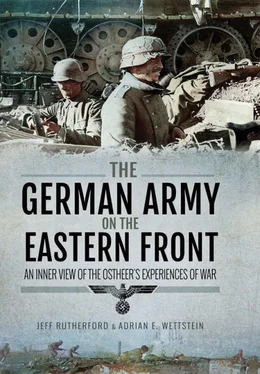This document also indicates the division’s attention to the region’s agricultural resources; clearly, the German army’s occupation duties encompassed far more than merely securing its lines of communication and supply. It also suggests that the division commander recognized the shift in the balance of power in the east. The army that invaded the Soviet Union in June 1941 had suffered grievous and irreplaceable casualties in terms of men and equipment and victory could now only be achieved if the occupied population remained quiescent or could perhaps be encouraged to fight on behalf of the Reich.
Simultaneous to the army’s implementation of more conciliatory policies were attempts by the Reich to more systematically exploit the manpower resources of the occupied territories. In spring 1942, the Nazi state instituted a new programme designed to deliver Soviet citizens to work in Germany’s fields, mines, and factories. Led by Fritz Sauckel, Gauleiter of Thuringia, the Reich Labour Action’s tentacles spread widely through the occupied east, working in concert with institutions such as the Economic Staff East, the SS, and the army. An order issued by the 8th Panzer Division’s quartermaster in May 1942 made clear the army’s role in the process. [32]
The very great need for workers in the Heimat demands the transfer of around 2,000,000 people from Russian territory.
The organs authorized with the recruitment of Russian workers by the General Plenipotentiary for the Labour Action, Gauleiter Sauckel, are to be supported by the units in every respect.
The army was thus inextricably involved in what eventually became a massive program of kidnapping and population displacement. [33]While millions of workers from the occupied east were eventually sent to Germany, the army also utilized hundreds of thousands of Russian men and women for its own purposes, from building and maintaining roads, to constructing defensive positions and improving lines of communication. A November 1942 order from Fourth Army emphasized the importance of civilian labour to the army itself. [34]
Due to the prevailing scarcity of prisoners of war, an increased use of civilian labourers as single workers and in labour columns will take place in the future.
These labourers must be treated differently than prisoners of war . Before requesting such labour forces, each military user of this labour must carefully consider the requirements of the civilian work force, such as securing food and shelter.
The deployment of civilian workers in labour columns especially requires precautionary measures in the following sense, as the danger exists that members of the labour columns could be unwilling to work or could flee from working through illicit means. Such people are easy loot for the gangs.
The issue of food, however, remained the most pressing for both occupiers and occupied. Unfortunately for German forces at the ground level and the starving civilians surrounding them, the German High Command squashed attempts, such as those of the 123rd Infantry Division, to feed the occupied territories’ population. In August 1942, the OKH delineated the field army’s responsibilities for civilians.
With the increasing difficulties in supplying the Russian civilian population with food directly before the harvest, the proposals from command authorities have become more frequent to place food from troop stocks at the disposal of the civilian population in the army and rear areas. As understandable as these proposals are from the troops’ standpoint and as desirable as this would be for the fulfilment of the requirements in the interest of population’s labour power and its willingness to work, their carrying out are just as untenable.
The serious situation of the Heimat ’s entire food situation itself makes it necessary for the population in the occupied territories to be left a minimum of food and in particular the circle of those who eat from German rations needs to be limited to the most necessary extent. Furthermore limited transportation capabilities, which can only partially satisfy all its users and due to the heavy troop demands for supplies of arms and ammunition and other goods of all types, only a relatively minimal space is allowed for food supplies on the trains, which in addition to the on-going supply, is barely sufficient to create the necessary stocks for the mud period and winter. All assistance from army stocks can therefore only have a negative effect on the troops’ own supply.
Supply for the civilian population is exclusively the task for the economic authorities.
The distribution of food from the troops’ stocks must be categorically prohibited and can only be limited to temporary assistance in individual cases subject to the application of strict standards, if a timely reimbursement of food is to be maintained by the economic authorities.
The OKH clearly recognized the benefits of feeding civilians in order to successfully carry out its other programmes, specifically those involving labour. Once again, however, severe supply difficulties intersected with the army’s utilitarian interpretation of military necessity and Nazi ideology, resulting in the end of policies that could have at least alleviated some of the worst effects of German occupation. This hard line taken by the High Command was mirrored by the actions and policies of many front-line units. Even the 123rd Infantry Division found itself straddling the line between conciliatory initiatives and simple violence. In an order it issued in October 1942, the German army’s struggle to reconcile its competing visions of an occupation order based on a mutually beneficial relationship with the peasantry and one based on violence was clearly articulated. [35]
The relationship of the troops to the population is decisive for the combating of agent- and partisan activity in Demiansk combat area. In general, the population has proven itself willing and hard working. Several parts are even prepared to provide armed support for the troops. There are within our area, however, still citizens who find it the best when the population has experienced a strict, but sympathetic treatment. It is essential that the population is convinced by our just behaviour and strictness, even in the future, and simultaneously feels itself protected from enemy agents by the consistency of our actions. Every weakness on our part will also be seen by the Russian population as a military weakness. This further undermines their obedience and trust in the troops. This would ease the work for agents and partisans.
The authority to carry out punitive measures against the population lays solely in the hands of the town commanders, the commander of the guard detachment, and the division. Sentences are to be imposed as non-judicial punishments (for example, imprisonment, if necessary with increased labour, including after the normal working hours, money and payment in kind). Corporal punishment is only to be used against men. It should be limited to exceptional cases. Punishments are to be recorded and filed.
German occupation policy continued to transform in 1943, marked by the catastrophic defeat suffered by Sixth Army at Stalingrad and the subsequent hasty retreat by elements of Army Group A to escape a similar fate in the Caucasus region. The army now fully committed to total war and this motivated its ever-evolving occupation policy. Two documents generated by the 126th Infantry Division, which was operating in Army Group North, highlight this transition at the divisional level. The notes from a meeting between members of the division and a group of Russian elders who administered villages in the region illustrate the army’s approach to occupation. [36]
1) Necessity of the total effort in the struggle against Bolshevism:
Читать дальше






![John Stieber - Against the Odds - Survival on the Russian Front 1944-1945 [2nd Edition]](/books/405234/john-stieber-against-the-odds-survival-on-the-russian-front-1944-1945-2nd-edition-thumb.webp)





